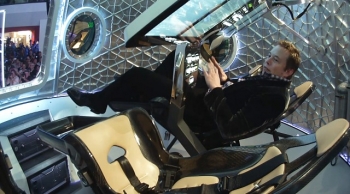SpaceX has unveiled what it hopes will be the future of manned, commercial spaceflight: The seven-seater Dragon V2 spaceship. It is very similar to the current, unmanned Dragon resupply spacecraft, but with the new ability to soft “land anywhere on Earth with the accuracy of a helicopter,” rather than the normal method of parachuting from the atmosphere into the ocean. This will allow the Dragon V2 to be reused up to 10 times before needing a full service, massively reducing the total launch cost. NASA currently pays Russia $63 million for a seat in a Soyuz capsule; a seat on the Dragon V2 would cost just $20 million. Viva la commercial space travel!
The Dragon V2 was unveiled by Elon Musk at SpaceX’s rocket factory in California. A full video of the presentation is embedded below, and I strongly recommend watching it. Externally the spacecraft looks like a more rounded, fenestrated version of the current Dragon capsule. Internally, you basically have seven fancy seats and a big array of screens, and not much else — kind of like the Tesla Model S, you might say. It kind of looks like a minimalist TARDIS from Doctor Who. I suspect the internals will probably change between this prototype stage and final production. (Note that this Dragon V2 prototype looks quite different from the first mockup, shown in March 2013). For now, I definitely prefer it over the cluttered, blue aesthetic of Boeing’s CST-100 (which will also be competing for a NASA contract).
Despite the addition of seats (and the necessary life support systems), by far the most exciting aspect of Dragon V2 is its ability to soft land back on Earth. The current version of Dragon is only equipped with weak retro rockets for maneuvering in zero-g space. Dragon V2 will be outfitted with eight SuperDraco rocket engines, which will produce enough thrust to safely land the spacecraft anywhere on Earth, “with the accuracy of a helicopter.” Musk says two of the engines can safely fail — and if something drastic goes wrong, there will still be a fall-back parachute that can be used for a conventional landing. In an attempt to tick off as many buzzwords as possible, Musk also pointed out that these engines included parts that had been created with metal 3D printing (SLS).
Thanks to its soft landing capability, and various other design decisions, the Dragon V2 will be fully reusable. Musk says it can be rapidly reused up to 10 times (basically just refilling the fuel tanks), and then it needs to be serviced properly (probably to check the heat shielding and other components that are stressed during atmospheric reentry). The only other spacecraft that has been reusable is the Space Shuttle. The Soyuz capsule, the current way of shuttling astronauts to and from the ISS, is thrown away after every use. By making the Dragon V2 reusable, rather than having to send up a brand new spacecraft every time, the total launch cost is massively reduced.
As far as SpaceX is concerned, reusability is the key to making space travel affordable — both in terms of big-budget plans to colonize the Moon or Mars, and for space tourism. Last month we saw SpaceX’s latest efforts to make the Falcon rocket reusable, by bringing it back to the launch pad after launch — and now we have Dragon V2. If everything goes to plan, SpaceX could cut the cost of putting a single pound of mass into orbit from the current price of between $5,000 to $20,000, down to $500 or less.
SpaceX’s Dragon V2 will compete with a bunch other private companies, including Boeing, Blue Origin, and Sierra Nevada, for a lucrative “space taxi” Commercial Crew Program contract from NASA. Since the Space Shuttle was retired, NASA has had to rely on Russia to get to and from the ISS, which obviously isn’t ideal, even without the Ukraine/Crimea tensions – and it’s also very expensive, at around $63 million per seat. The total launch cost for Dragon V2 is expected to be around $140 million, or $20 million per seat. The first CCP flight will occur sometime in 2017, if everything goes to plan.
Source : extremetech.com
